





SEPTEMBER 2022 • Vol.09 • No.09 Embracing automation to StrEamlinE corE Hr FunctionS - Frank Diassi, Chairman, Unicorn (ISSN 2564-2030) The State of Today's HR Tech Stack 2022-23 Page 23-38Sponsored by:
the
To A Stronger, More Attractive
Plan
to leverage your employee retirement plans to engage and retain talent
- Shaya Rose, Account Executive and Production Leader, HUB Group
Bjorn Reynolds,
Embracing automation to Streamline core Hr Functions
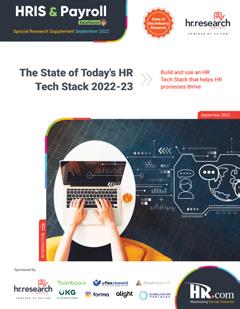
What HR must consider to ensure a smooth transition

- Frank Diassi, Chairman, Unicorn
39 Is Gladwell Wrong About The Future Of Work?
Lessons to learn from Apple workers’ petition against return-to-office
Chantel Rowe, VP, Product Management, Topia
How Metaverse Will Affect Human Resources
From employee performance tracking to identifying security threats, metaverse will change everything
Eaven Portillo, Co-Founder and COO, Sortium
Nowhere
Nancy Romanyshyn, Director, Pay Strategy & Partner Success,
07 On
Cover in DEX HRIS & Payroll Excellence September 2022 Vol.09 No.09 (ISSN 2564-2030)
Articles 10 4 Tips
Retirement
How
18 Four-Day Workweek: Addressing The Needs Of A Modern Workforce The future of work is “work in any way” -
Chief Executive Officer & Chief Guardian, Safeguard Global
-
47
-
47
To Hide: How To Prepare For Total Pay Transparency 4 key steps to prepare for pay range transparency -
Syndio the State of today's Hr tech Stack 2022-23 Page 23-38
Top Picks
Digital Transformation: Reaching Across The Aisle


CHROs and CIOs need to work together to lead responsible growth
- Dave Campbell, CEO & Co- Founder, Tropic
Gig Economy: FTC Ramps Up Gig Worker Protections
More power to gig workers
- Leonard L. Gordon, Alexandra
Megaris, Michael A. Munoz & Joshua Nace, Associates, Veneble LLP
Pay Transparency Law
How California’s precedent-setting will impact employers
- Emily Scace, Legal Editor, XpertHR
How Life Planning Accounts Can Meet Employees’ Evolving Needs


Life planning accounts have never been more vital
- Rob Whalen, Co-Founder and CEO, PTO Exchange
14 21 44 49
INDEX
How are our HRIS & Payroll Products and Services helping to make you smarter?
HRIS & Payroll Excellence - Monthly Interactive Learning Journal
This monthly interactive learning experience captures key metrics and actionable items and keeps you focused on your Core HR: Payroll for HR and HRIS management goals and solutions.
HRIS and Payroll Webcasts for Credit

HR.com webcasts deliver the latest HRIS and Payroll industry news, research trends, best practices and case studies directly to your desktop. Webcasts are available live online with a downloadable podcast and a copy of the slides (PDF) available before and after each webcast. Earn all of the required recertification credits for aPHR, PHR, SPHR, GPHR, and SHRM Certifications. HR.com’s one-hour webcasts, in every HR specialty including HRIS and Payroll, are pre-approved for HRCI and SHRM credit (excluding Demo webcasts).
HRIS and Payroll Virtual Events

Virtual Events in the HRIS and Payroll program merge human resources management as a discipline with basic HR activities and processes within the information technology field. With continuous offerings of new technologies in the HR industry to improve HR practices and efficiencies in payroll and any information systems, there’s a boundless need for education as well as surveillance of systems integration. Each Virtual Event consists of up to 10 credit webcasts.
Payroll for HR and HRIS Community
Join over 37,000 HR.com members with a similar interest and focus on Payroll for HR and HRIS. Share content and download research reports, blogs, and articles, network, and “follow” peers and have them “follow” you in a social network platform to communicate regularly and stay on top of the latest updates. This well established Payroll for HR and HRIS Communities are an invaluable resource for any HR professional or manager.
Use these invaluable HRIS & Payroll resources today! For more information phone: 1.877.472.6648 | email: sales@hr.com | www.hr.com
Editorial Purpose
Excellence Publications
Director (Product, Marketing, and Research)
Babitha Balakrishnan and Deepa Damodaran Excellence Publications Managers and Editors
HRIS & Payroll Excellence Team
Deepa Damodaran Editor

Chinnavel
Design and Layout (Digital
Vibha
(Online
Submissions & Correspondence
Debbie mcgrath Publisher, HR.com
automating Your Hr Processes
EDitor’S not
Deepa Damodaran Editor, HRIS & Payroll Excellence

Awell-oiled
HR department is key to the success of a company. HR departments help operations run smoothly by taking care of the most valuable part of any size organization – its employees - while reinforcing company culture.
However, managing every aspect of an employee’s needs is no simple task. From benefits enrollment to payroll to report ing, HR administration processes are complex and time-consuming, to say the least.
To streamline and automate these processes, many organizations are replacing manual, paper-based processes with cloud-based software and mobile technology.
Learn how automation can help HR streamline core HR processes in Embrac ing Automation To Streamline Core HR Functions by The Unicorn Group’s Frank Diassi.
According to a Gartner survey, over half of CHROs reported the shortage of critical talent as the number one trend im pacting organizations, yet only 19% said their organization is prepared to bridge the gap. At the same time, as the pace of digital transformation continues across the enterprise, companies are also work ing to ensure that the right technology and tools are in place to remain competi tive.
While, the former seems to be more of an HR concern and the latter that of the
IT, it can cause tension between the two departments if not addressed on time. Tropic’s Dave Campbell believes this is an opportunity for CHROs and CIOs to rethink the way they plan and budget in a way such that it leads to business growth.
Check out Dave’s article, Digital Transformation: Reaching Across The Aisle, to learn how the two department heads can work together to a better future with digital transformation.
XpertHR’s Emily Scace, in her article Pay Transparency Law talks about the landmark SB 1162 legislation, accord ing to which California employers with 15 or more employees will be required to include salary ranges in job postings and provide the pay scale for a position upon request to an applicant or current employee.
Also, read How Life Planning Accounts Can Meet Employees’ Evolving Needs by Rob Whalen and Gig Economy: FTC Ramps Up Gig Worker Protections by the experts at Veneble LLP.
That is not all! We have featured several other articles this month, and hope this edition of HRIS & Payroll Excellence will help you achieve excellence in your HRIS and payroll processes.
Happy reading and don’t forget to send us your feedback!
at
Disclaimer: The views, information, or opinions expressed in the Excellence ePublications are solely those of the authors and do not necessarily represent those of HR.com and its employees. Under no circumstances shall HR.com or its partners or affiliates be responsible or liable for any indirect or incidental damages arising out of these opinions and content.
Write to
E
Subscribe now for $99 / year And get this magazine delivered to your inbox every month Become a Member Today to get it FREE! SIGN UP OR For Advertising Opportunities, email: sales@hr.com Copyright © 2022 HR.com. No part of this publication may be reproduced or transmitted in any form without written permission from the publisher. Quotations must be credited.
Our mission is to promote personal and professional development based on constructive values, sound ethics, and timeless principles.
Debbie McGrath CEO, HR.com - Publisher Dawn Jeffers VP, Sales Sue Kelley
Magazine)
Magazine
Version)
Please send any correspondence, articles, letters to the editor, and requests to reprint, republish, or excerpt articles to ePubEditors@hr.com For customer service, or information on products and services, call 1-877-472-6648 HRIS & Payroll Excellence: (ISSN 2564-2030) is published monthly by HR.com Limited, 56 Malone Road, Jacksons Point, Ontario L0E 1L0 Internet Address: www.hr.com
the Editor
ePubEditors@hr.com
In a world of unparalleled challenges (global pandemic, racial injustice, politi cal rivalry, digital 4.0, emotional malaise), uncertainty reigns. Finding opportu nity in this context requires harnessing uncertainty and harnessing starts with reliable, valid, timely, and useful information. The Excellence publications are a superb source of such information. The authors provide insights with impact that will guide thought and action.
Dave ulrich
Rensis Likert Professor, Ross School of Business, University of Michigan

Partner, The RBL Group
Excellence publications are my ‘go-to’ resource for contemporary and action able information to improve leadership, engagement, results, and retention.
Each edition offers rich and diverse perspectives for improving the employee experience and the workplace in general.

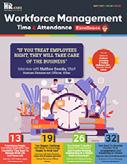

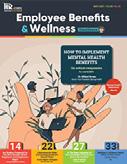
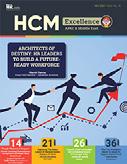




Julie Winkle giulioni
Author, Virtual /Live Keynote Presenter, Inc.’s Top 100 Leadership Speakers

I regularly read and contribute to Leadership Excellence and Talent Manage ment Excellence. I use many of the articles I read to augment my own presen tations and I often share the articles with my clients. They are always quick, right on target for the latest issues in my field, and appreciated by my clients.
If you want to stay up to date on the latest HR trends, choose a few of the dif ferent issues from the Excellence series of publications.


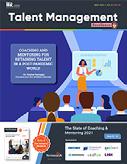

Dr. beverly Kaye
CEO, BevKaye&Co.

We’re eager to hear your feedback on our magazines. Let us know your thoughts at ePubEditors@hr.com WHY EXCELLENCE PUBLICATIONS?
Embracing automation to Streamline core Hr Functions
What Hr must consider to ensure a smooth transition
By Frank Diassi, The Unicorn Group
Awell-oiled HR department is key to the success of a company. HR departments help operations run smoothly by taking care of the most valuable part of any size organization – its employees - while reinforcing company culture.

By managing the entire employee lifecycle from onboarding to retirement and everything in between, HR departments ensure employee satisfaction and engagement which, in turn, results in increased business productivity.
However, managing every aspect of an employee’s needs is no simple task. From benefits enrollment to payroll to reporting, HR administration processes are complex and time-consuming, to say the least. To streamline and automate these processes, many organizations are replacing
manual, paper-based processes with cloud-based software and mobile technology.
Implementing a centralized HR platform provides real-time information for executives to understand personnel trends and gives employees more control of the services offered to them,
including self-service options. Additionally, automating HR tasks allows organizations to be more proactive. The strategic objective is to transform a system of HR/ payroll/benefits management into a platform of engagement that unifies human resources departments, employees and employers.
Submit Your ArticlesHRIS & Payroll Excellence presented by HR.com September 2022 7
coVEr articlE
Of course, creating a fully automated HR department does not happen overnight. If you are looking into starting this process today, consider automating the following tasks first to ensure a smooth transition.
Onboarding and Benefits Enrollment
Two of HR’s most time-consuming tasks are onboarding benefits for new hires and managing open enrollment each year. Automating this process through a centralized web-based program makes administering benefits infinitely easier for HR departments and employees by facilitating the enrollment process. From an HR perspective, it reduces paperwork and data entry while giving companies the ability to integrate payroll into benefits administration. Combining these two functions allows HR departments to accurately track withholdings and contributions.
A central database that details healthcare and retirement options eases the burden on employees as well. Employees can review all benefits options with their families from home and at their leisure, allowing them to make more informed decisions. Benefits can also be easily changed and updated according to life events, such as marriage, divorce, and the birth or adoption of a child.
Payroll
Processing payroll involves many moving parts. Managing pay rates, deductions, and overtime for full-time, part-time, hourly and/ or seasonal employees can be
cumbersome and often leaves payroll/HR staff inundated with documentation. Cloud-based HR software can help to automate these activities, making payroll administration more accurate and more efficient than manual processes.
Automating payroll also provides employees with self-service tools that allow them to make changes to their personal information and manage their own direct deposit options. Employees themselves have built-in tools to calculate various “what if” scenarios that would impact their take-home pay, such as contributing to a com pany-sponsored 401(k) Plan. This streamlines payroll administration and frees payroll/HR staff from handling such requests.
records management and reporting
Understanding the myriad of different local, state, and federal business regulations is a challenge in and of itself. Needless to say, understanding which regulations to apply to your organization, then implementing those regulations and maintaining the appropriate records is a daunting task. While most organizations know that records and reports must be kept for a certain amount of time, many are not aware that recordkeeping regulations vary widely depending on a company’s state and industry.
Automated HR software takes the frustration out of compliance, reporting, and record keeping with a two-fold solution. First, instead
of being buried under a mountain of paperwork, HR software provides a centralized database, where companies can securely store and search for records.
Second, automated HR software can keep companies apprised of new compliance guidelines, as well as changes in federal and state regulatory matters.
Overall, automating key HR functions with cloud-based software can transform HR administration into a simple and efficient system of record. The right software will enable HR departments to standardize processes, reduce errors, and free up time for HR to focus on other business initiatives. At the same time, employees will have more control and be empowered to manage their own records.
Frank Diassi, Chairman at Unicorn HRO and Managing General Partner for The Unicorn Group, has over 40 years of experience in business leadership. Frank is a former Director of Mail-Well Corporation and Chief Executive Officer of Sterling Chemical. He had major corporate experience with Conoco Oil Company for 10 years where he held a senior business unit management position in the petrochemicals area. Would you like to comment?

Submit Your ArticlesHRIS & Payroll Excellence presented by HR.com September 2022 8
Embracing Automation To Streamline Core HR Functions
y Do you have expert payroll knowledge to share?
y Do you have great ideas for improving payroll education and training?
y Interested in being at the forefront of an engaging, new Payroll Certification?
guide the next frontier of education and certification

Join our Payroll Advisory Panel to
Calling Payroll Experts… HR Needs Your Expertise! Learn More
4 t ips to a Stronger, more attractive retirement Plan
How to leverage your employee retirement plans to engage and retain talent
By Shaya Rose, HUB Group Retirement
According to one survey, Canadians will need to save roughly $1 million before they reach retirement age. Yet with many unable to save as much as they would like, 20% of Canadians are concerned they will outlive whatever savings they have.
Enter the savvy employer offering a modern retirement package. Not only can retirement plans be used to
attract new talent, but they can also support current employees searching for guidance. Those nearing retirement may need direction on how to spend their retirement savings. Younger employees may need incentives to invest in the plan in the first place.
What’s more, employers looking to cut costs to ensure sustainability of the plan may need to revisit their

Submit Your ArticlesHRIS & Payroll Excellence presented by HR.com September 2022 10
offerings. Group retirement plans must be regularly monitored and updated to achieve compliance and encourage employee participation.
Follow these best practices to achieve all your goals with your Canadian group retirement plan:
1. Offer Tiered Contribution Design
If you’re looking to increase employee loyalty and retention, a tiered contribution plan can help.
Many employers have offered to match employee contributions up to a certain amount, such as 5% of salary. In a tiered contribution, employers match employee contributions up to 3% of salary in the first five years, but may match contributions up to 4% or 5% in years six through 10 or beyond 10 years.

This increase in matching rewards employees for their loyalty and also encourages them to increase contributions over time. For many employees, this may be an incentive to stick around.
2. Introduce a Deferred Profit Sharing Plan.
A deferred profit sharing plan (DPSP) gives employees the opportunity to share company profits. A DPSP brings many benefits to the table, including:
● A vesting period of up to two years, encouraging employees to stick with the organization
● The company recovers 100% of its contribution if the employee leaves before the vesting period is complete
● Tax savings for the employer, as contributions are paid pre-tax and are tax-deductible
● Employees who leave the company after the vesting period can convert their plan into an RRSP, tax-free, or another investment vehicle
3. Include Target-date Funds as an Option
Employees like easy options, and target-date funds are one of the simplest to use and understand. Target-date funds mix several types of investments, from stocks and equities to bonds. The asset allocation changes over time to become more conservative and risk-averse.
Usage of target-date funds in Canada has grown from 7% of workplace retirement plans in 2010 to 30% in 2020, and its popularity continues to grow. These funds make it easy for employees to hold a balance of investments to better prepare for the future – without investing a significant amount of time in those investments.
4. Support Retirement Planning
As earners approach retirement age, the biggest shift is yet to come. Envisioning the retirement years can be a challenge for those who have spent their life working. They may have questions about taxes and XXX, including:
● What happens to retirement accounts in retirement?
● How do retirement accounts translate into income that lasts?
● What is more tax efficient?
● How do workplace retirement savings mesh with Canadian Pension Plan and Old Age Security benefits?
Organizations can provide added benefits to their employees by offering educational resources to guide them through their post-working years. These resources may include workshops, webinars, and even simple printed materials that offer support in managing income during retirement.
Shaya Rose is an Account Executive and Production Leader for HUB Group Retirement, with nearly 10 years of consulting experience in group retirement plans. Shaya has expertise in cross-border strategies for both Canadian group retirement plans and U.S. 401k plans.
Would you like to comment?
Submit Your ArticlesHRIS & Payroll Excellence presented by HR.com September 2022 11
4 Tips To A Stronger, More Attractive Retirement Plan










 Marshall Goldsmith
Executive Coach
Courtney McMahon Vice President of People Analytics Colgate Palmolive
Beverly Troxtell Head of HR Change Management & HR Evolution PayPal
Linda Cai Head of Talent Development LinkedIn
Melanie Tinto CHRO Wex
Nikita Steals Head of Talent Acquisition Capital One
Dave Sachs Senior Director People Analytics and Data Science Northwestern Mutual
Ryan McCrea Head of Learning & Development Atlassian
Marshall Goldsmith
Executive Coach
Courtney McMahon Vice President of People Analytics Colgate Palmolive
Beverly Troxtell Head of HR Change Management & HR Evolution PayPal
Linda Cai Head of Talent Development LinkedIn
Melanie Tinto CHRO Wex
Nikita Steals Head of Talent Acquisition Capital One
Dave Sachs Senior Director People Analytics and Data Science Northwestern Mutual
Ryan McCrea Head of Learning & Development Atlassian
2022 SPEAKERS Inspiring keynotes · Educational sessions, panels and workshops for industry thought leaders · Intimate round table discussions with hot topics ·1 on 1 meetings with partners and key suppliers · Guided market tours · Product demos Industry leaders will share their experience, vision, and innovations over three packed days in Nashville. Join them at an event filled with fun, parties, networking and collaboration! October 5 - 7, 2022 Nashville, Tennessee SAVE UP TO $750 Get your conference pass for as low as $300 REGISTER NOW
Top Ten Business Thinker Author/Editor
https://www.hr.com/InspireHR-attend hr.com/InspireHR-attend




















SAVE UP TO $750 Get your conference pass for as low as $300 REGISTER NOW SPONSORS & EXHIBITORS IMAGINE THE POTENTIAL OF HR AND YOU! https://www.hr.com/InspireHR-attend hr.com/InspireHR-attend 2022 TOPICS LEADERSHIP & BEING THE BEST LEADER POSSIBLE EMPLOYEE EXPERIENCE & WELLBEING TALENT MANGEMENT SKILL DEVELOPMENT DIGITAL TRANSFORMATION TALENT ACQUISITION Bring your team! Group pricing is available. Contact CorporateEducation@hr.com for more information.
Digital transformation: reaching across t he aisle
cHros and cios need to work together to lead responsible growth
By Dave Campbell, Tropic
The summer of 2022 could be coined the summer of layoffs. Cutting staff, hiring freezes and rescinded job offers have plagued a variety of industries, impacting companies like Netflix, Twitter, Compass and more. It seems like, every time I log on to LinkedIn, someone else in my network is announcing that they lost their job.
Even amidst this climate, HR leaders continue to fight the war for talent, using their bag of tricks and tools to attract and retain top performers. However, doing so against a backdrop of cost cutting and capital preservation requires working doubly hard. According to a Gartner survey, over half of CHROs reported the shortage of critical talent as the number one trend
impacting organizations, yet only 19% said their organization is prepared to bridge the gap.
At the same time, as the pace of digital transformation continues across the enterprise, companies are also working to ensure that the right technology and tools are in place to remain competitive.
While these two competing priorities might seem like a natural source of tension within the executive suite, there is an opportunity for CHROs and CIOs to rethink the way they plan and budget. Working together, this duo may be a strategic weapon in the era of responsible growth.

Submit Your ArticlesHRIS & Payroll Excellence presented by HR.com September 2022 14
top Pick
So, where should HR leaders begin?
understand the inextricable link between People and Software budgets
People and software are often a company’s biggest line items. While it used to be that companies hired people and bought software, today there is an inextricable link between the two domains. When a people or technology strategy goes awry, the impact on time, money and employee productivity can quickly skyrocket.
Today there is a blurring of lines between people and tech as every new hire also means new tech requirements. Hiring is no longer just a salary decision for companies; they also must consider the cost of software licenses or tools that each new employee may require - think Zoom, Gmail, or Slack.
It is, precisely, because of this intersection that a partnership between CHROs and CIOs may be one of the most important ways to ensure that capital flows to the organization’s highest priorities. Instead of battling for resources, HR leaders should use this moment to engage their technology counterparts as collaborative partners in budget discussions.
Examine Your SaaS contracts and think about opportunity costs
Work with your CIO to evaluate your software contracts and the people policies around them. Just knowing what you are spending is one of the most important steps for identifying ways to reduce spend. It can be a daunting task as most companies rely on and manage at least 100 different software tools, but it is an essential step. Knowing how many tools and software platforms your company actually have is just a starting point.
However, beyond just the numbers, make sure you are working with your colleagues to understand the fine print, especially when contracts are up for renewal. The devil is often in the details and nobody wants to be caught off guard by a big cost or unexpected autorenewal, especially if it comes at the cost of headcount.
I learned this the hard way when I was working at Microsoft. One of our biggest customers was struggling to meet their business priorities and they were coming up for renewal. Of the 300 products they were paying for, I discovered that most of them were not even being used. When their request to review their deal and find the funds to meet the terms of their contract was denied, they had little choice but to lay off staff.
This was a tradeoff I could not abide by, so I resigned from Microsoft and started my company Tropic that same day so that more businesses didn’t need to choose between their people and their tech.
be Part of getting Software Spending under control
Coming off the recent growth frenzy, it is understandable how software spend has so gotten out of control. Companies sought out best-in-class technologies as a way to compete, but this came at a high cost, and not just financially. For example, there were instances of employees purchasing new software on their personal credit card, without any knowledge of related policies, opening up their companies to serious cybersecurity risks.
In some cases, businesses were signing contracts for platforms they never ended up even using or without knowing when auto-renewals were set to kick in. Our data has shown that on average, companies can wind up overspending on software by up to 30% without the right processes, data and people in place.
With companies throwing away an estimated $40 billion a year on SaaS tools they do not need or use, it is difficult to bring the amount of software waste and overspending all the way down to zero. However, CIOs and CHROs can work together to put clear processes in place, leaning on automation and dynamic workflows to centralize the purchasing process.
In addition, these leaders can survey their employees to understand which tools are being used and which ones are not, and perhaps more importantly, which ones are providing the most value.
Digital Transformation: Reaching Across The Aisle
Submit Your ArticlesHRIS & Payroll Excellence presented by HR.com September 2022 15
What we have also found at Tropic is that companies may actually learn some interesting things about their workforce when they look at their software utilization figures. This data can provide businesses with insights into engagement levels, headcount trends and who is making the most of the SaaS tools at their disposal, ultimately helping them make smarter decisions about where they allocate their resources.
make tough choices as a team
With a collaborative partnership and newly found SaaS savings in place, encourage your CIO partner to make tough choices with you as a team. I have led the move away from siloed budget cuts, where some amount of cuts need to be made in both headcount and tech spend to move the needle on your business goals.
Before making the tough decision to cut people, work with your CIO to find room to optimize the way you are using your company’s software. Remember that you can always procure new software licenses at a future date, but top talent will be much more challenging to replace, not to mention the damage layoffs can do to morale and culture.
In the present economy, as CHROs continue to focus on talent recruitment and retention and CIOs examine ways to fuel innovation and growth through technology, cost-cutting mandates remain top of mind.

At Tropic, I encourage continued conversations between HR and IT to make sure that any decisions we make around our people and tech investments are not being made in a vacuum. And when the economy eventually improves (as it always does), I strongly believe that this advanced foresight and collaboration will help prevent companies from cutting too close to the core such that they are not able to bounce back.
Dave Campbell is the CEO & CoFounder of Tropic.
Would you like to comment?

Submit Your ArticlesHRIS & Payroll Excellence presented by HR.com September 2022 16
Digital Transformation: Reaching Across The Aisle
London
Empower HR Tech Europe brings together credible practitioners who are at the height of HR technology to an immersive event experience.



Our six-track conference showcases what is possible, what is realistic and what the next steps are. HR Professionals will take away specific, measurable, actionable, realistic and timely tactics that tie into their business needs.


FOR THE U.K. AND EUROPE
With formats designed to foster an environment of inclusiveness and honest discussion, Empower HR Tech Europe will allow you to collaborate with your peers, industry experts and solution partners through every element:

A NEW KIND OF HR INDUSTRY EVENT
Keynotes Concurrent Conference Sessions Workshops Panel Discussions Demonstrations Round-Table Brainstorming Expo Tours Video Montages Fringe Networking 1:1s with Peers, Partners, Influencers & Analysts Fun and MORE! · · · · · · · · · · · SAVE UP TO £440 Early Bird Ends 18 Nov 2022! REGISTER NOW hr.com/empowerhreurope-attend Bring your team! Group pricing is available. Contact CorporateEducation@hr.com for more information. CHART YOUR PATH IN OUR UNCERTAIN WORLD OF WORK 25-26 January 2023 ExCeL Venue,
Addressing The Needs Of A Modern Workforce Through A Four-Day Workweek

The future of work is “work in any way”
By Bjorn Reynolds, Safeguard Global
The early results are in, and they shouldn’t be a surprise to HR and business leaders worldwide: employees trying out a four-day
workweek in the U.K. in the biggest workplace experiment of its kind say their new schedule is a game-changer.
Many of the 33,000 workers--who represent 70 companies participating in the trial--say the new schedule enables them to take up new hobbies, pursue longer-term goals and improve their home lives, all without sacrificing productivity. These results echo a smaller trial of the four-day workweek in Iceland last year, which was so successful that shorter working hours are now an option for more than 85% of the country’s workforce.
In the larger U.K. trial, employees are being paid the same for working 80% of the hours. And because they are boosting their mental health and finding better work-life balance with their additional time off, they are completing tasks in four days that used to take five.
Submit Your ArticlesHRIS & Payroll Excellence presented by HR.com September 2022 18 Submit Your ArticlesHR Strategy & Planning Excellence presented by HR.com August 2022 30 Four-Day Workweek: addressing t he needs of a modern Workforce
TOP PICK
This knowledge is changing the workplace in fundamental and permanent ways. Now that employees know they can successfully work remotely and be more productive with less hours, they want the flexibility to do their jobs in ways that work for them. It’s up to employers to embrace a people-centric approach to workforce management and provide an environment that allows them to perform at the top of their game. Failing to do so could easily mean losing top talent to a competitor who is willing to create people-centric work policies.
Our team at Safeguard Global has worked relentlessly through significant upheaval these last three years, just as we know many around the world have. Our employees deserve flexibility as we’ve seen that they will use it to achieve, and even exceed the goals they have in front of them. That is why we have decided to launch our own trial of the four-day workweek.
Addressing the Needs of a Modern Workforce

Our trial began about a month ago with ten of our remote engineers, who follow asynchronous schedules and are used to putting in extended hours for special projects. As we work through this trial to see if the four-day workweek helps us to better support our teams’ work-life balance, we’re keeping an eye on the progress of our teams and communicating with them frequently about how they feel the four-day week is affecting their ability to do their job, their job performance and work-life balance.
As we monitor overall sentiment and productivity, we’re making adjustments to our program based on their feedback and the trends we’re witnessing. So far, we’re seeing a positive impact on the team’s performance. In fact, the team has improved a lot of the metrics that matter
such as the quality of work and our retention rate. Our Chief Technology Officer reports that team members have been creative, eager, and engaged – and when new challenges arise, they are able to quickly problem solve with the new flexibility and freedom to set their schedules.
We’re looking at the results of this trial from a qualitative perspective to see if outcomes align with our expectations of more energized, engaged, and motivated employees. In the next two months, we plan to expand the four-day week to our operations centers, where we employ over 1,200 people across six different countries. By the end of this year, we will know whether performance benchmarks are being met – such as quality of work, quarterly results, daily deliverables, and the impact on our clients. Depending on these results, we’ll know whether Safeguard Global is set to join the four-day movement as one of the largest global employers putting a premium on employee well-being.
Addressing The Needs Of A Modern Workforce Through A
Submit Your ArticlesHRIS & Payroll Excellence presented by HR.com September 2022 19 Submit Your ArticlesHR Strategy & Planning Excellence presented by HR.com August 2022 31
Four-Day WorkweekFour-Day Workweek: Addressing The Needs Of A Modern Workforce
It’s important to note that the four-day workweek is not the only way we’re experimenting with the best ways to balance employee workload and avoid burnout. There is never a single solution. We’re looking at numerous initiatives, whether it be implementing required holidays, designated PTO hours, wellness weeks, etc., and exploring how they would work for different teams. We know all teams will not react or work better with the same structures – we need to be deliberate in identifying the different approaches. But this is going to help shape the future of work for our company, to be a Work in Any Way company.
The Future of Work is “Work in Any Way”
Every company, and often each department within it, is different and requires a unique approach to meet their goals. The four-day work week is not a one-size-fitsall approach that will generate the same results across the company. It’s just one example of what I like to call a “Work in Any Way” mentality that puts employee needs and flexibility at the forefront.
The world of work was radically altered by the pandemic with the larger company adoption of remote work and now the great resignation, where a record number of 47.4 million American workers voluntarily quit their jobs in 2021. As a result, people are increasingly realizing the traditional 9-5 work model doesn’t work for them. Employees want more than just a flexible workspace - they want a flexible work experience.
Culture plays a significant role in determining which job offers workers accept, how long they stay and how well they perform. And now that employees have proven they can excel in unconventional environments, they are demanding the flexibility to do their jobs in ways that better suit their schedules, their relationships, and their mental health.
companies support a diverse array of workstyles and workplace cultures around the world.
The question is: how is your company adjusting to let your people work in any way?
The question is: how is your company adjusting to let your people work in any way?
HR and business leaders have had a front-row seat to the evolving global workscape and identified different ways to restructure how our teams work, not just through the lens of what is best for the company, but also what is best able to serve the needs of our workforce. We are increasingly erasing geographic borders, reconfiguring office space, updating remote work policies, and allowing employees to choose between being remote-first or traditional office environments. Our mission has always been to transform how people work. Ten years ago, that meant helping organizations hire and pay their employees globally. Today, it means helping
If a valuable employee wants or needs something out of the ordinary, it might not be simple to accommodate them. And in the past, the answer might have been “no.” But there is a revolution in the workplace today because employees have learned how much they can accomplish. And the future is all about “getting to the yes.” The four-day workweek is one way some of us are getting there – how are you?
Bjorn Reynolds is Chief Executive Officer & Chief Guardian at Safeguard Global
Would you like to comment?

Employees want more than just a flexible workspace - they want a flexible work experience.
Submit Your ArticlesHRIS & Payroll Excellence presented by HR.com September 2022 20 Submit Your ArticlesHR Strategy & Planning Excellence presented by HR.com August 2022 32
Addressing The Needs Of A Modern Workforce Through A Four-Day Workweek
Four-Day Workweek: Addressing The Needs Of A Modern Workforce
gig Economy: Ftc ramps up gig Worker Protections
more power to gig workers
By Leonard L. Gordon, Alexandra Megaris, Michael A. Munoz & Joshua Nace, Veneble LLP
The buzz around gig economy protections continues as the Federal Trade Commission (FTC) took yet another action to safeguard gig workers. Last week, the FTC adopted a policy statement asserting its authority to address unfair and deceptive practices and anticompetitive conduct that harms workers in the gig economy.
The statement highlights data from several studies concerning the gig economy, including that it is expected to generate $455 billion in annual sales by 2023, and that 16% of Americans report earning income through an online gig platform. The statement also reports that, while gig work has already established itself in food delivery and transportation, it is now expanding into healthcare, retail, and other segments of the economy. The FTC noted that the decrease in demand for transportation during the Covid-19 pandemic illustrates “the precarious nature of gig work.”
The FTC statement focuses on three features of the gig economy “that implicate the Commission’s consumer protection and competition missions:”
1. control without responsibility
This relates to what many, including the FTC, see as the misclassification of gig workers as independent contractors rather than employees. The FTC states that misclassification:
● Deprives workers of critical rights, like overtime pay, health and safety protections, and the right to organize
● Burdens workers with undue risks, like unstable pay and responsibility for vehicles or other equipment
● Burdens workers with business expenses that the employer should bear, like insurance and gas
2. Diminished bargaining Power
The statement discusses a “power imbalance” that “leave[s] gig workers more exposed to harms from unfair, deceptive, and anticompetitive practices and is likely to amplify such harms when they occur.” According to the FTC, this power imbalance is characterized by:
● Algorithms that dictate workers’ relationship with a gig platform and leave workers with “an invisible, inscrutable boss”
● Little leverage to demand transparency from gig companies
● Commonly used mandatory arbitration clauses and class-action waivers
3. concentrated markets
The statement asserts that many gig platforms exist in
Submit Your ArticlesHRIS & Payroll Excellence presented by HR.com September 2022 21
toP PicK
concentrated markets and, therefore, are “more likely to have and exert market power over gig workers or engage in anticompetitive unilateral or coordinated conduct.” Here, the FTC is concerned that loss of competition in these markets will enable gig platforms to suppress wages, reduce job quality, or impose onerous terms on gig workers.
The FTC plans to “use the full portfolio of laws it enforces” to protect gig workers from unfair, deceptive, and anticom petitive practices, regardless of how gig companies choose to classify their workers. The FTC’s enforcement priorities listed in the policy statement include:
● Holding gig companies accountable for claims they make to prospective workers about costs and benefits of gig work. This includes claims about potential earnings, lack of clarity regarding how pay is calculated, and undisclosed costs or terms of work.

● Combating unlawful practices and unlawful constraints imposed on



gig workers. The FTC is concerned with the automated or algorithmic control exerted over gig workers and the lack of transparency that results. Moreover, the FTC views restrictive, “take-it-or-leave-it” contract terms as potentially unfair or deceptive if they unfairly harm workers, render a gig company’s representa tions misleading, or prevent fair competition for workers. The expansion of the FTC’s unfairness authority to cover employment relationships (on both the consumer protection and competition missions) has the potential to vastly expand the FTC’s role in the gig economy and elsewhere.
● Policing unfair methods of competition that harm gig workers. The main concerns here are wage-fixing and coordination, as well as market consolidation and monopolization. The statement highlights the FTC’s intent to investigate evidence of wage-fixing, non-poaching agreements, and technology-enabled methods of collusion or exclusion. The FTC will also review and, if necessary, challenge mergers that it believes will harm competition for workers.
The commissioners split in adopting the agency’s new policy statement in a 3-2 vote.
Republicans Noah Joshua Phillips and Christine S. Wilson dissented,

illustrating the continuing political divide on the commission. At an open meeting, Wilson said the statement was “another step in the effort to shift the Commission’s attention from its traditional mission of protecting consumers and competition to an agenda focused largely on ‘workers.’ Abandoning the consumer welfare standard, as this Policy Statement purports to do, will harm consumers.”
Earlier this summer, we reported that the FTC has concentrated its efforts on protecting gig economy workers, and more recently we discussed the formation of a new partnership with the National Labor Relations Board. The FTC is now firmly in the employee protection business.
Gig Economy: FTC Ramps Up Gig Worker Protections
Leonard L. Gordon and Alexandra Megaris are Partners, and Michael A. Munoz and Joshua Nace are Associates at Veneble LLP. Would you like to comment?
Submit Your ArticlesHRIS & Payroll Excellence presented by HR.com September 2022 22
The State of Today's HR Tech Stack 2022-23



Build and use an HR Tech Stack that helps HR processes thrive


Sponsored by: Special Research Supplement September 2022 INTERACTIVE September 2022
INDEX

RESEARCH REPORT SUMMARY
The State of Today's HR Tech Stack 2022-23
Exclusive Research from HR Research Institute
Survey conducted by: Sponsored by:

 ARTICLE
ARTICLE
31 35
How to Improve FMLA Management with Technology

 By Seth Turner, AbsenceSoft
By Seth Turner, AbsenceSoft


From Foraging to Modern Technology: The Evolution of Life and Work
By Karina Monesson, UKG
The HR Research Institute, powered by HR.com, the world’s largest social network for Human Resources professionals, is a key part of our mandate to inform and educate today’s HR professionals. Over the past three years, the HR Research Institute has produced more than 85 exclusive primary research and state of the industry reports, along with corresponding infographics in many cases, based on the surveys of thousands of HR professionals. Each research report highlights current HR trends, benchmarks, and industry best practices. HR Research Institute Reports and Infographics are available online, and always free, at www.hr.com/featuredresearch
27
The State of Today's HR Tech Stack 2022-23

Build and use an HR Tech Stack that helps HR processes thrive
Exclusive Research from HR Research Institute


Sponsored by:

With a globally dispersed workforce, technology has become indispensable to organizations. It enables them to connect with employees working in remote locations, provides them with the required support to conduct their work, and effectively manages them.
An increasing number of organizations are today interested in learning more about HR tech stack and how it can be leveraged to meet their organizational objectives.
New research by HR.com’s HR Research institute, ‘The State of Today’s HR Tech Stack 2022-23’, explores various topics related to the HR tech stack, including the most commonly included capabilities, various issues, challenges and pain points, strate gic alignment of the HR tech stack with business objectives, impact on key business outcomes, and more.

STATE OF THE INDUSTRY RESEARCH25
Below are the top findings from the study:
Finding #1: Payroll is the most commonly included capability in today’s HR tech stack One of the major utilities of any given HR tech stack is to increase HR efficiency through streamlining and automating core HR functions.
Payroll (79%) and benefits administration (70%) are the topmost widely cited capabilities, as they are two of the most important functions in an organization. Recruitment/talent acquisition (67%) and onboarding (67%) follow closely.
Survey Question: Which of the following capabilities are included in your organization's HR tech stack? (select all that apply)
Payroll
Benefits administration
Recruitment/talent acquisition
Onboarding
Learning and development
Performance management
Workforce management (e.g., scheduling, attendance)
Employee experience
Total rewards
Succession planning/management
About half (47%) of organizations include employee experience capabilities in their HR tech stack
26 STATE OF THE INDUSTRY RESEARCH
0 10 20 30 40 50 60 70 80 79% 70% 67% 67% 60% 59% 48% 47% 28% 27%
Do your Payroll and HCM systems work well together?

Simplify your pay cycles every time by seamlessly collecting, storing, and sharing HR data within a single system.
Find out more on alight.com.
Finding #2: Two-thirds (67%) say investment in their organization’s HR tech stack has increased
More than a quarter (27%) say investment in their HR stack has increased a lot over the past two years, and a further two-fifths say investment has increased a little. Just 7% say investment in their HR stack has decreased.
Finding #3: Most respondents are looking to enhance process automation with their organization’s HR tech stack
When asked to select the top issues that organiza tions are trying to address with their HR tech stack, respondents selected the following four:
● enhance process automation (61%)
● provide useful people data and analytics (61%)
● provide employee self service (60%)
● enhance employee experience (60%)
Survey Question: What issues are you trying to address with your organization's HR tech stack?
Enhance process automation
Provide useful people data and analytics
Enhance employee experience
Provide employee self service
Integrate talent management solutions
Career pathing and mapping
Allow mobile access
Reinforce the desired corporate culture
Advance key performance indicators (KPIs)
Skills and/or personality assessments
Increase diversity and inclusion
Identify high potentials
Increase pay equity
Facilitate internal referrals
Just 26% are using their HR tech stack to identify high potentials
28 STATE OF THE INDUSTRY RESEARCH
0 10 20 30 40 50 60 70 80 61% 61% 60% 60% 44% 43% 43% 37% 35% 34% 29% 26% 21% 19%







Wednesday, November 2 & Thursday, November 3, 2022 8:00 AM–1:00 PM PT / 11:00 AM–4:00 PM ET Discover new ways to elevate your work & grow your people at the world’s largest virtual HR conference! 100% Free HR Virtual Summit Get top-notch HR & business insights from 60+ industry leaders. Earn SHRM & HRCI recertification credits. Count Me In!
Finding #4: Most organizations have two or more solutions in their HR tech stack
Today’s organizations have a rich array of choices when it comes to HR technology solutions.
Three-fifths of the respondents said their orga nization uses 2 to 4 paid solutions from different providers and 23% use 5 or more. Logically, larger organizations are more likely to use a use greater number of HR solutions when compared to small and mid-size organizations; 23% of larger organi zations use 8 or more HR solutions.
Finding #5: Sixty-two percent agree or strongly agree their organization’s HR tech stack increases/improves organizational efficiency/productivity
Many organizations look to their HR tech stack to enhance the employee experience, organizational efficiency/productivity and HR’s efficiency/produc tivity. The HR tech stack can be used to automate,
simplify and digitize operations also while enabling collaboration so that organizations are better able to achieve these goals. Technology also enables organizations to collect data points regarding employee experience that can be utilized to identify pain points and areas of improvementimprovement.

Over half agree or strongly agree that their HR tech stack improves the employee experience (54%) and organizational efficiency/productivity (57%), and 62% say it improves HR’s efficiency/productivity.
To learn much more about the survey on The State of Todays HR Tech Stack - HR.com and for key insights and strategic takeaways, we invite you to read the complete report here
Read the Research Report
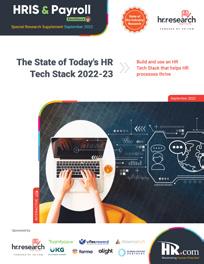
30 STATE OF THE INDUSTRY RESEARCH
How to Improve FMLA Management with Technology
Seth Turner, AbsenceSoft

Managing FMLA can be a complex, time-consuming process for HR professionals. It is a big undertaking to make sure eligibility is calculated correctly for every case, the right forms and communications are sent on time, and the leave taken is accurately tracked. This can be challenging, especially if FMLA management is just a small part of your overall role.
In this article, we will review some of the most important parts of managing a typical FMLA request. We will also discuss how you can leverage technology to implement best practices and improve your overall process.
Calculating Eligibility and Entitlements
There are numerous calculations that go into determining if an employee is eligible for FMLA, including total hours worked and length of service. With the average award for an FMLA lawsuit being $400,000, it is critically important to make sure you calculate leave eligibility correctly every time.
But if you do not have access to a system that provides historical data on the length of service, accessing these details—and making sure they are correct—can be a scramble. Without a centralized system of record, bridging service dates for employees that depart the company and come back can also be a challenge.
This is where technology can save time and improve accuracy. Leave software serves as a central location where you can store and access each employee’s complete, historical length of service and hours worked. It can also track the previous time taken, which could impact eligibility. In just a few seconds, the system can automatically calculate FMLA eligibility for each case.
Once eligibility is determined, leave technology can automatically calculate exactly what entitlements an employee is eligible for. It can centralize federal and state leave laws, as well as company-specific policies, and apply them to each case automati cally. In one centralized system, leave managers can quickly determine not only FMLA eligibility, but other leaves each employee could be eligible for as well.
Sending the Initial Packet
FMLA processes include sending out an eligibility packet, along with a rights and responsibilities notice, within five days. Depending on what type of leave is being requested, your state may require you to send additional forms and notices within a certain time frame as well.
In this part of the process, setting clear expectations with the employee is key. No matter why someone is requesting FMLA—health conditions, caregiving, or even a positive life
STATE OF THE INDUSTRY RESEARCH31 ARTICLE
change, such as maternity leave—they are all dealing with the stress a life change brings. As a leave manager, you want to be as clear and informative as possible to avoid adding to their stress or anxiety.
Federal and state regulations have rules about when forms and other information should be sent, and complying with all of them is not always easy. You need to be sure each employee requesting leave receives the right information, and that you are able to document what you sent and when. With state laws changing more frequently, you have to make sure you are sending the most up-to-date forms to stay compliant.
Rather than sorting through folders, downloading forms, and writing an email from scratch, leave management software can automatically generate

a customizable packet for you. Even better, the system is updated automatically when federal and state law changes, so you know you are sending the most up-to-date forms and other required com munications. Instead of relying on spreadsheets, the software also can serve as a system of record, tracking when and what information was sent.
Reviewing the Medical Certification
Once the packet is sent out, you must receive it back from the employee within 15 days. However, employees often struggle to get certifications back within the allowed time, which can impact the entire process.
Leave managers can help by sending a reminder (or two) before the due date. However, when you are managing multiple cases, knowing when to do this for each employee can mean relying on post-its, email reminders, and spreadsheets.
A better, more reliable option is to let leave management software track due dates and send reminders for you. In one location, you see all the due dates for each case, and set up custom, automated reminders. This can really help employees know exactly what they need to return and when they should return it by.
When you get a certification back, you should thoroughly review everything to make sure it is complete and accurate. This can include following up to make sure doctors and other providers are valid, and that they have fully completed all of the necessary forms.
Leave technology provides a central, easy-toaccess location for tracking, storing, and reviewing

STATE OF THE INDUSTRY RESEARCH32 ARTICLE
certifications. Leave managers can even add case notes and quickly request additional information if needed.

Approving or Denying Leave
Leave managers must always make sure they properly and consistently approve or deny leave. Improperly denied leave can lead to a lawsuit or failed audit, so you may want to seek out second opinions on more complex or challenging cases to ensure you make the right call.
After a leave is approved, communication becomes even more essential. Employees don’t request FMLA very many times in their lives, so leave managers should be as informative as they can. You want to be sure to communicate clear expectations about what employees should and should not do when out on leave, as well as what to expect from your end in terms of follow-up and tracking.
Leave management software provides a faster and easier way to set expectations and communicate if the leave was approved or not. You can create a set of standardized, consistent, and thorough communications that can be easily customized for each request. Leave managers can also receive automated reminders and alerts to make sure they send approvals or denials within five days to comply with federal law.
Case Management
FMLA case management involves a lot of tracking. You need to know when leave starts, when certifications expire, and when leaves are exhausted. Leave managers can end up with
folders covered in post-it notes, calendars filled with one-off reminders, and multiple spreadsheets.
Having to comply with a complicated web of state, local, and company-specific policies—that can make employees eligible for different leaves—can make tracking even more of a challenge. With multiple competing priorities and so many dates to track, it is not hard for leave managers to inadvertently miss some.
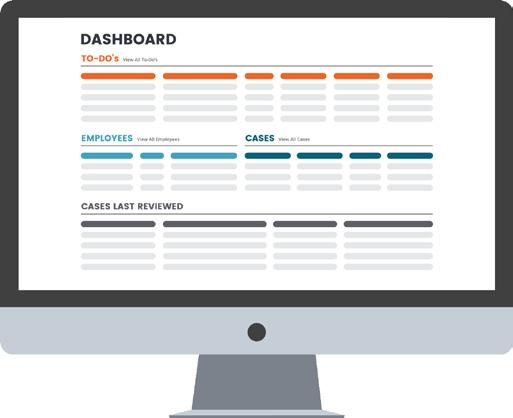
Leave management technology gives you the tools you need to never miss a key date or lose track of an employee on leave. In one view, leave managers can easily see how long an employee has been gone, when certifications are ending, and their return date. You can even create an automated, streamlined process for employees who need to have a leave recertified.
Helping Employees Return to Work
Leave managers should always have a process for supporting employees in their return to work.
STATE OF THE INDUSTRY RESEARCH33 ARTICLE
Bringing people back to work is beneficial to both the business and the employee. Some studies have shown that recovery can accelerate once employees get “back in the swing of things.” As a leave manager, you’ll want to really think through how you can make each employee’s return to work as seamless as possible.
Leave and accommodations management software enables HR professionals to automate and streamline many of the tasks involved in a successful return to work. From notifying managers to updating critical systems, leave managers get the tools they need to save time, reduce errors, and improve retention.
Technology Benefits
Managing an FMLA case end-to-end is a time-con suming, complex process without leave technology. Many HR professionals find themselves relying on spreadsheets, email reminders, post-it notes, and gathering data from multiple systems. They can easily spend hours making sure they send the right forms and communications at the right time, verify critical details, make accurate decisions, and track multiple leaves. With so much time spent on admin istrative tasks, leave managers are left with little to no time to interact with the employees in their care.
This situation leaves much to be desired by everyone involved. By integrating leave management software into the FMLA process, leave managers can simplify, streamline, and optimize nearly all of the tasks involved. The risk of a lawsuit or fine is greatly reduced as well, because leave managers are equipped with the technology they need to deliver a consistent, well-documented, and fully tracked process. By spending 66% less time on FMLA management tasks, leave managers
get time to focus on what’s most important: caring for their employees.
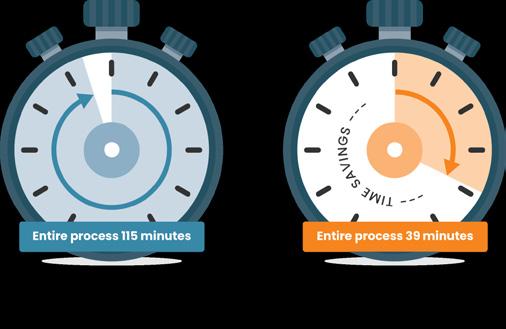
To learn how software can transform your FMLA management, we invite you to schedule a demo of AbsenceSoft at: absencesoft.com

Seth Turner has over 20 years of experience helping clients solve their HR and absence management issues. As Co-Founder and Chief Strategy Officer of AbsenceSoft, Seth is responsible for evaluating strategic partnerships and product opportunities. Prior to co-founding AbsenceSoft, Seth held leadership roles at Hewitt Associates, Mercer, and Reed Group, all focused on outsourcing and technology solutions for leave of absence and employee benefits. Seth has an MIS degree from Indiana University and an MBA from Northwestern University. Would you like to comment?

STATE OF THE INDUSTRY RESEARCH34 ARTICLE
From Foraging to Modern Technology: The Evolution of Life and Work
Karina Monesson, UKG
What Is Life-work Technology?
More than 90% of employees say the pandemic has changed their life-work development in some way. Meanwhile, HR departments have been a focal point for connecting and supporting people in the light of vast changes that may be becoming perma nent.
Is your business equipped with the best possible tools to keep up? Learn more about Life-work tech nology and the benefits UKG solutions can offer for getting the most from your people while supporting them on their journeys. Learn more.
Our relationships with “life” and “work” are compli cated.
This is clear from the evolution of the term “worklife balance”. Countless variations have made headlines during the past four decades: work-life negotiation, work-life integration, work-life synergy, and more. Our concepts of life and work evolve, and our technology needs to evolve with it.
Never has this been more apparent. As our world reels from a global pandemic amid economic, social, and environmental uncertainty, business and HR leaders are exhausted. So is everyone else. A mountain of research suggests life-work dissat isfaction played a leading role in the Great Resig nation, crippling many companies and industries
as they have struggled to operate and provide the salaries the “market demands.”

And so, while we certainly need technology tools to attract and retain talent for this current crisis, the truth is that we need much more than that. We need solutions that are truly people-focused, that are lifeaware, that support team members holistically both at work and in their personal lives. If history has taught us anything, it is that technology in service of business often comes at the expense of people. The time has come to refocus technology on help ing people, which positively impacts the business.
Most business leaders do not consult macro-level historical trends when making key decisions. As humans, we are also prone to a recency bias, believ ing that everything has always been as it is now. It is easy to forget that there is a fascinating history to this thing we call work. So how did the modern workday come about? And what have we learned about work from these key moments in history?
Ancient History
For most of modern humankind, there were no “jobs.” People worked, of course; survival required hunting, foraging, outrunning predators, and con stantly moving as part of a nomadic lifestyle. But these everyday responsibilities were basically “life.”
Current anthropologic studies show the average male spent 5.3 hours per day hunting and foraging,
STATE OF THE INDUSTRY RESEARCH35 ARTICLE
tasks that were largely leisurely and communal in nature. (Hunting is about 10 parts watching and walking to one part chasing and killing.) These cul tures give us a pretty good glimpse into what this elusive “balance” looked like for our ancestors.
This changed when the Neolithic Revolution began. Over the course of hundreds, if not thousands of years, humans learned to farm by domesticating plants and animals for food. This promise of a reliable, stationary food source allowed permanent settlements, and population grew quickly.
It is not an exaggeration to say the invention of ag riculture changed everything, including introducing the concept of “work.” Work became more than a combination of daily tasks ensuring survival; people now had specialized jobs that distinguished them from their peers and provided skills or products that could be bartered or sold.
People began working longer hours than they had in their hunter-gatherer days, and the first seeds of social class division and wealth disparity were sown. Thousands of years later, this segregation
led to the “working class,” the “elite,” and enslaved labor. For those in the middle—the more affluent working class, like shop owners and artisans—it is estimated that many worked a 6-hour day.
Read the complete article here


As Senior Manager of HCM Research and Advisory, Karina Monesson supports UKG’s thought leadership research strat egy and partners closely with business leaders to help them maximize the value of their people and technology invest ments. A former journalist and market researcher, Karina speaks regularly with conference and customer audiences about HCM trends and best practices, and her work has been featured in Forbes, SHRM, HR Dive, HR Executive, HR Daily Advisor, and Human Resources Today. She is passionate about leveraging research, data, and technology to improve peoples’ lives and drive systemic change.

Would you like to comment?
STATE OF THE INDUSTRY RESEARCH36 ARTICLE
Our purpose is people Learn more at UKG.com/why-ukg

Let’s make the workplace worth smiling about.
HR solutions that will keep your people happy.

The State of Today's HR Tech Stack 2022-23 HRIS & Payroll Excellence September 2022 For more information: 1.877.472.6648 sales@hr.com www.HR.com/epubs The HR Research Institute tracks human resources trends and best practices. Learn more at hr.com/featuredresearch
is gladwell Wrong about t he Future of Work?
lessons to learn from apple workers’ petition against return-to-office
By Chantel Rowe, Topia
Recently, best-selling author Malcolm Gladwell issued a scathing critique of remote work, telling those who work from home that “it is not in your best interest.” The author, whose books have been practically required reading for business leaders and entrepreneurs, was immediately rebuked on social media for his

harsh criticism. Many even argued Gladwell was being hypocritical, having spent nearly all of his quite successful career working remotely. If he can be productive remotely, why can’t they?
While Gladwell is right to be concerned about remote workers needing to feel a
sense of belonging within the organization—and organizations absolutely should address this—his critique seems out of touch with the experience and expectations of today’s modern workforce. In short: Remote workers are doing just fine and forcing them back to the office is a talent disaster in the making
Submit Your ArticlesHRIS & Payroll Excellence presented by HR.com September 2022 39
Case in point: Just recently, Apple employees launched a petition protesting the company’s return-to-office plan, arguing that flexible work—the ability to work from wherever they choose—is essential for productivity, diversity, inclusion, and ultimately, the future success of the company.
As other big tech firms like Facebook, Twitter, Google and more—that largely compete for the same pool of talent as Apple—have implemented permanent flexible work policies, Apple’s return-to-office demand is extremely risky. Last year, 41% of employees said the flexibility to work from home was a reason to change jobs, and 64% of workers say they’re more likely to seek a
new job if forced to return to the office full-time. Can Apple afford to lose that many employees?
Furthermore, contrary to Gladwell’s assessment, flexible work arrangements do not mean “sitting in your pajamas in your bedroom,” but rather giving employees the option to come into the office or work elsewhere on their own terms. For some, that may mean working from home during school holidays so they can be with their children, or from their parents’ house for two weeks to help out with a project or provide essential care. For others, it might mean extending their upcoming holiday trips home, or taking an extended “workcation” where they can remain emerged in a culture or environment longer—a valuable experience for both personal and
professional growth—while also being productive and contributing to the organization. Still, others might just need an occasional change of scenery to gain a fresh perspective.
Certainly, the office will continue to be valuable in a post-pandemic workplace—some people need that separate space or the energy that comes from being among colleagues—but employees don't want a one-size-fits-all mandate. In fact, 94% of employees say they should be able to work from anywhere as long as they get their work done, while 78% believe teams in the future will be agile and it won't matter if everyone is in the same location. Employees want flexibility, meaning they may want to be together in an office, just on their own timelines and terms.
 Is Gladwell Wrong About The Future Of Work?
Is Gladwell Wrong About The Future Of Work?
Submit Your ArticlesHRIS & Payroll Excellence presented by HR.com September 2022 40
Not to mention, forcing employees back to the office will have a negative impact on Diversity, Equity and Inclusion (DEI) efforts that had been improving with the shift to remote work. Topia’s recent Adapt survey found that 43% of HR leaders have been able to hire a more diverse group of employees since embracing remote work. As the Apple employees’ petition points out, some individuals have disabilities, caretaking obligations and health, safety and environmental concerns that make it impossible for them to be in the office five days a week. Even a hybrid schedule that’s set by their employer requiring specific in-office days isn’t “flexible,” but is rather what I call “forced flexibility.” With truly flexible work, individuals have the freedom to fit work around their life rather than the other way around. By stripping employees of this autonomy, companies risk losing out on a more diverse talent pool.

Finally, Gladwell’s frustration with the inability of “leadership
complexity for companies in areas like employment law, payroll, tax and immigration, which is a valid concern. That’s why it’s more important than ever for HR leaders to implement the proper technology to effectively manage remote work, so they can give employees the flexibility they want while also safeguarding the company’s interests.
to explain this effectively to their employees,” also seems a bit out of touch with modern management. This top-down approach to enforcing policy from the perspective that leadership knows best disregards employees’ needs, is antiquated and demonstrates a lack of trust in them. The reality is, happy employees are much more productive, and allowing them to work remotely, away from the distractions of the office, can help them to get more work done. Trusting employees to balance their life and work is a win-win for employees AND the company.
Regardless of what leaders want, modern employees demand control over when and where they work, and they’re not afraid to go elsewhere to get it. In fact, 96% say that flexibility in work arrangements is a top priority when seeking a new job. Therefore, employers must embrace flexibility in order to attract and retain top talent and remain competitive today and in the future. Certainly, this flexibility can introduce added
Chantel Rowe is the VP of Product Management at Topia. Chantel’s career has always found itself at the intersection of Global Talent Mobility and technology. She firstly spent 8 years at EY specializing and qualifying in US, UK, French and International taxation of globally mobile employees and managing key customer accounts on a global basis. Wanting to experience challenges from another perspective, she managed EMEA Mobility, Tax and Payroll for Société Générale, and eventually became a customer of Topia herself! Seeing the opportunity to be part of transforming the world of global work through technology, she joined the Topia family in 2015 – firstly building our amazing solutions consulting team of industry experts, and then transitioning to lead our Product organization and bring her years of mobility expertise to designing, building and delivering our technology solutions.
Would you like to comment?
 Is Gladwell Wrong About The Future Of Work?
Is Gladwell Wrong About The Future Of Work?
Submit Your ArticlesHRIS & Payroll Excellence presented by HR.com September 2022 41
CERTIFICATION PREP COURSES
GROUP RATES AVAILABLE
For HR Professionals
Show that management values the importance of the HR function, and has a commitment to development and improvement of HR staff.
Ensure that each person in your HR department has a standard and consistent understanding of policies, procedures, and regulations.
Place your HR team in a certification program as a rewarding team building achievement.
For Your Organization
Certified HR professionals help companies avoid risk by understanding compliance, laws, and regulations to properly manage your workforce.
HR Professionals lead employee engagement and development programs saving the company money through lower turnover and greater productivity and engagement.
A skilled HR professional can track important KPIs for the organization to make a major impact on strategic decisions and objectives, including: succession planning, staffing, and forecasting.
TODAY TO
MORE 1.877.472.6648 ext. 3 | sales@hr.com
HRCI® & SHRM®
HR.com/prepcourse CALL
FIND OUT
1 Less expensive than a masters or PhD program, and very manageable to prepare with
2. legislation and best practices
3. Recognized, Industry benchmark, held by 500,000+ HR Professionals
1 2 3
Group Rate Options
We offer group rates for teams of 5+ or more for our regularly scheduled PHR/SPHR/ SHRM or aPHR courses.
For groups of 12+, we can design a more customized experience that meets your overall length of the course.
Groups rates for HRCI exams are also available as an add-on.
All group purchases come with 1 year of HR Prime membership for each attendee to gain the tools and updates needed to stay informed and compliant
sales@hr.com | HR.com/prepcourse

CALL TODAY TO FIND OUT MORE 1.877.472.6648 ext. 3 |
Pay transparency law
How california’s precedent-setting will impact employers
By Emily Scace, XpertHR
With the stroke of a pen, Governor Gavin Newsom signed a precedent-setting law that establishes pay transparency and modifies reporting obligations for private employers in California.
Under the landmark SB 1162 legislation, California employers with 15 or more employees will be required to include salary ranges in job postings, and all
employers will be required to provide the pay scale for a position upon request to an applicant or current employee.
In addition, the state’s pay data reporting law, implemented in 2021, is amended to expand the employers required to submit data and require

Submit Your ArticlesHRIS & Payroll Excellence presented by HR.com September 2022 44
top Pick
employers to calculate mean and median pay by race, ethnicity and sex, along with other minor changes.
With the nation’s most populous state joining the list of those requiring pay information in job postings, this law is likely to significantly move the needle on pay transparency in the United States.

What Employers need to Know
● The legislation, which will take effect in January 2023 is the latest example of a push to improve pay transparency efforts. New York City, Colorado and Washington also require salary ranges in job postings, and a similar bill is awaiting signature in New York state.
● Employers who fail to comply could face civil lawsuits and state penalties.
● Planning and implementing an approach to transparency may prove challenging for California employers subject to the law— particularly if there are existing pay disparities that come to light as a result.
● With more states joining the pay transparency push, practices like disclosing compensation in job postings will become the expectation rather than the exception, and employers who are behind the curve may struggle to attract and retain talent.
● Employers are likely to have significant blind spots when it comes to pay equity. According
to XpertHR research, while just over 1 in 4 employers believe pay inequity exists in their organizations, over 4 in 5 employers that conducted a pay equity audit had to adjust pay as a result.
What Employers Should Do now
It’s critical for employers to review their existing pay structure and practices with an eye to identifying and fixing disparities. For an employer with a robust pay equity strategy in place, transparency is nothing to fear and can even be a selling point.
Emily Scace is the Legal Editor at XpertHR. Emily has nearly a decade of experience in legal publishing, with expertise in topics including employment discrimination laws, pay equity, recruiting and hiring, and more.
Would you like to comment?

Submit Your ArticlesHRIS & Payroll Excellence presented by HR.com September 2022 45 Pay Transparency Law

ePublication Editorialcalendar2022 CheckoutthenewandupcomingthemedHR topicsinHRIS&PayrollExcellence. Check ePublications Editorial Calendar Here. Would you like to submit an article? | Write to us at ePubEditors@hr.com Submission Guidelines 1 Payroll 2023 Dec 2022 2 HRIS Tech 2023 Nov 2022 3 Pay and Compensation 2022-23 Oct 2022 4 AI and Automation in HR Sep 2022 5 Wage and Hour Aug 2022 6 HR system: Cloud or On-Premise July 2022
How Metaverse Will Affect Human Resources
From employee performance tracking to identifying security threats, metaverse will change everything
By Eaven Portillo, Sortium
Metaverse and Web3 technology has exploded into consumer consciousness in the last two years with no signs of stopping. According to a report from Grayscale, we saw the all-time value spent on metaverse items like virtual land, goods, and services skyrocket from $50 million in December 2020 to over $207 million less than a year later. This massive investment in virtual environments will have a significant impact on the business community, particularly in human resources.
The key issue surrounding this melding of technology and industry is privacy. With every employee action being tracked and recorded as businesses move into the metaverse, we will see the average privacy concerns regarding workplace data magnify exponentially. This data could be used to assess employee performance and identify potential safety and security issues.
1. Assessing Employee Performance
As businesses are given more access to data on their employees, evaluations could change dramatically. Where once your output, attitude, and results were the determining factors for how well an employee performed their job, the emergence of data tracking may result in things like how well you did or how attentive you were with a customer in a virtual space.
That said, there are certainly positives. For instance, the metaverse may allow employers to identify workers’ strengths more easily, as well as their weaknesses.
2. Identifying Potential Safety Issues
While people will mostly be using avatars in the metaverse, many companies are turning to eXtended Reality, or XR, in response. This combination of virtual, augmented and mixed realities allows for a more organic approach to the metaverse workplace, by allowing a real person to interact in a virtual environment, rather than using traditional blocky/ cartoon avatars.
Regardless of how the employee’s presence is projected, they will be interacting in what will still constitute a work setting. Companies must remain serious about how exactly to oversee this virtual space to avoid problematic behavior, such as harassment, abuse, or bullying.
A good guide would be to determine what constitutes such behavior in the virtual world, integrate the definitions into your workplace policies and educate employees on inappropriate behavior in the metaverse. As interactions are codified in the data, spotting harassment and workplace turmoil will lead to swifter action ensuring all employees enjoy a safe workplace.
Submit Your ArticlesHRIS & Payroll Excellence presented by HR.com September 2022 47HR Legal & Compliance Excellence presented by HR.com SEPTEMBER 2022 7 Submit Your Articles
COVER ARTICLE
3. Identifying Potential Security Issues
As employees will likely be connecting remotely to start, ensuring that non-employees do not gain access to the workplace metaverse will be paramount. Companies will need to safeguard the connection process to ensure that each login only allows approved users.

The safest bet here is the tried-and-true 2FA authentication process with a real authenticator, not SMS 2FA which has lately been compromised with SIM cloning. With increased digital security measures, companies will be able to better protect their employees and the company’s confidential information.
In the metaverse, privacy concerns will be magnified as every action is tracked and recorded. As a result,

HR departments will need to develop new policies and procedures to protect employees’ privacy and ensure that their actions are not being unduly monitored.
Technology will also have to catch up in order to process this level of data capture.
Metaverse
Eaven Portillo is Co-Founder and COO of Sortium Would you like to comment?
Submit Your ArticlesHRIS & Payroll Excellence presented by HR.com September 2022 48HR Legal & Compliance Excellence presented by HR.com SEPTEMBER 2022 8 Submit Your Articles How
Will Affect Human Resources
How life Planning accounts can meet Employees’ Evolving needs

life planning accounts have never been more vital
By Rob Whalen, PTO Exchange
HR teams face a multi-dimensional crisis when hiring and retaining employees. First, high inflation and other economic stresses tighten balance sheets and make investing in human capital more difficult. Second, the talent competition is ferocious and turnover rates have surged. Lastly, employee demands and expectations have changed dramatically – workers want more support and greater flexibility than ever before.
In other words, HR professionals have to get creative with the benefits they offer their workforce. One of the best ways to meet employees’ needs without putting extra strain on the budget is by establishing life planning accounts (LPAs). Companies can use LPAs to offer employees a spending account that gives them a wide array of useful reimbursements tailored to their specific needs – from healthcare to retirement savings to financial planning.
Submit Your ArticlesHRIS & Payroll Excellence presented by HR.com September 2022 49
top Pick
In addition, LPAs can be customized to fit any company’s budget while giving individual employees options that appeal to them.
LPAs provide the flexibility employees want without significantly increasing the company’s expenditures, which makes them powerful and cost-effective tools for improving employee well-being and engagement. However, to fully leverage LPAs, companies have to focus on how they are funded, administered, and communicated to employees. We recently published a whitepaper that examines each of these areas and provides a guide for how companies can use LPAs most effectively, so let us take a closer look at a few of the key points.
Funding and covered Services
After over two years of working remotely, employees prioritize independence and flexibility like never before. According to a recent survey conducted by Deloitte, 94 percent of employees say they would “benefit from work flexibility, with the top gains being less stress/improved mental health, and better integration of work and personal life.” This is why
your LPA should offer many options that appeal to a diverse group of employees, regardless of their age, career aspirations, or work environment.
Traditional wellness programs often fail to meet the needs of modern and increasingly diverse workforces – for example, on-site health services, such as gyms or bicycle storage do not help remote workers. LPAs, on the other hand, give all employees a range of opportunities – from yoga classes to exercise equipment to nutrition counseling (to stick with the health and wellness example).
Companies can seek input from employees about their top needs to ensure their LPA program offers the best selection of services possible. Employees can use their LPAs to cover unexpected expenses, travel, tutoring or daycare, and just about anything else.
Companies also have to decide how they want to fund their LPAs; it’s vital to find a balance between financial benefits that employees view as negligible and benefits that place too much stress on the budget (an annual contribution of around $1,000 per employee is
 How Life Planning Accounts Can Meet Employees’ Evolving Needs
How Life Planning Accounts Can Meet Employees’ Evolving Needs
Submit Your ArticlesHRIS & Payroll Excellence presented by HR.com September 2022 50
a good guideline). HR teams can also reallocate funds from under-used benefits to reduce the cost of the program. And no matter how companies deploy LPAs, they need to make sure they have broad stakeholder support.
transparency and open communication are Essential
When an HR team decides to implement an LPA, the first step is to have an open discussion with employees about which benefits they need. Companies should never make assumptions about the benefit their employees find valuable. Instead, they should conduct focus groups, send out surveys, and have one-on-one conversations to determine which services will benefit their employees the most.
The whole purpose of LPAs is to help out your workforce as much as possible, so the process of developing the program should be employee-centric.
Once you have an LPA framework in place, it is crucial to educate employees about the services they are receiving as a part of the LPA and how to access those benefits. Create a simple and intuitive single document that includes what is covered, eligibility requirements, and how to collect reimbursements. Then use every communication tool your company has available to distribute this information across your workforce – email and text messages, social media, Zoom calls, and in-person meetings. Employees can not take advantage of the LPA if they do not know it exists.
At a time when just 21 percent of employees are engaged at work and a mere 33 percent say they’re thriving (according to the latest data from Gallup), it is clear that companies have a lot of work to do when it comes to building healthy work environments. LPAs can help companies engage employees by opening up lines of communication about their specific needs and concerns.
The process of building an LPA will not just provide benefits employees will actually use, but it will also make them feel like their voices are being heard.
lPas give companies a competitive advantage
While almost two-thirds of new hires say they prefer flexible benefits over cash incentives, just 10 to 15 percent of midsize to large employers offer LPAs. Our research also indicates that similar benefits (such as flexible paid time off) are extremely popular with employees – 70 percent say these benefits would make them feel valued and appreciated while 90 percent say the benefits would make them more likely to stay with their current employers.
As companies struggle to recruit and retain employees, LPAs and other flexible benefits can inspire loyalty, which is something employers need now more than ever before.
To get the most out of your LPA, consider outsourcing administration to a third party with streamlined payroll interfaces and automated processes to make it easier for company leaders and employees to use and manage.
These third parties sometimes offer online marketplaces that provide discounts and other useful benefits to employees that they can access through their LPAs. The last thing you want is for your LPA program to go unused because they do not know how to use it.
Regardless of how you deploy your LPA, employees will thank you for benefits that meet their unique needs. This will not just make for a happier and more productive workforce – it will also give you a critical advantage in a labor market that is becoming more competitive by the day.
Rob Whalen is Co-Founder and CEO of PTO Exchange. Would you like to comment?
 How Life Planning Accounts Can Meet Employees’ Evolving Needs
How Life Planning Accounts Can Meet Employees’ Evolving Needs
Submit Your ArticlesHRIS & Payroll Excellence presented by HR.com September 2022 51
Submit Your Articles
The Future of Diversity, Equity and Inclusion 2022 October 18, 2022
The State of HR Skills and Education 2022 October 19, 2022
The Future of Compensation and Total Rewards October 25, 2022
View our Upcoming Virtual Conference Schedule and Register Today!
Top 5 HR Metrics Every Organization Should Track
Hiring for Potential: Rethinking what Qualified Candidates Look Like
How to Be a Diversity and Inclusion Ambassador: A Three-Part Framework
Embracing an Empathy Strategy© to Go Beyond DE&I
The Benefits of Resilience and Successfully Navigating Change in a FastPaced Workplace
October 4, 2022 12:00 PM - 1:00 PM ET
October 13, 2022 11:00 AM - 12:00 PM ET
October 14, 2022
11:00 AM - 12:00 PM ET
October 18, 2022
4:00 PM - 5:00 PM ET
October 19, 2022
11:00 AM - 12:00 PM ET
View our Upcoming Webcasts Schedule and Register Today!
rEgiStEr
rEgiStEr
rEgiStEr
rEgiStEr
rEgiStEr
rEgiStEr Virtual EVEntS & Hr.com WEbcaStSuPcoming www.hr.com/upcoming_webcasts www.hr.com/virtualconferences
WE bca S t S
rEgiStEr
rEgiStEr WE bca S t S V irtual EVE nt S
Nowhere To Hide: How To Prepare For Total Pay Transparency
4 key steps to prepare for pay range transparency
By Nancy Romanyshyn, Syndio
Ready or not, investors, employees, and now lawmakers are moving pay from the shadows and into the open with:
● Expanding calls for pay gap disclosures from shareholders;
● Job board Indeed automatically posts your
pay ranges if you don’t supply them;
● Snowballing salary sharing practices among workers, and now;
● New pay range transparency laws spreading from Colorado and Jersey City to NYC in November and Washington and likely CA in January
For many companies, this means there is little left to hide and most are preparing for nation-wide disclosures.
What Challenges Are Companies Facing?
Unfortunately, disclosing pay ranges comes with a host of risks. According to a recent Syndio survey of over 400 companies, 87% have “major concerns” about complying with the new regulations. What are companies’ top concerns?

Submit Your ArticlesHRIS & Payroll Excellence presented by HR.com September 2022 53 HR Legal & Compliance Excellence presented by HR.com SEPTEMBER 2022 12 Submit Your Articles
Top Pick
(1) Posting the “right” ranges:
● Too low to compete for top talent: Because of the historically competitive talent market over the last 18 months, with market data and merit budgets moving at a record pace, and the current salary ranges may no longer be competitive, putting them at risk of turning away talent before candidates have even applied
● Too high, alienating current employees: The salaries of current employees may not have kept pace with the market over the years, so posted ranges could lead to disengagement and attrition at best and PR crises and legal risk at worse, if impacted employees fall into protected categories
● Too wide, leading to penalties: Regulatory requirements mean that if ranges are too wide, companies can be penalized, giving them little wiggle room to try to please incumbents and new hires alike with broad ranges
(2) Talking about pay ranges
● 2 in 5 surveyed companies said that “employees seeing current ranges” and “explaining ranges/ PR strategy” were their biggest concerns
● As ranges get shared, employees will want to
understand the company’s pay philosophy so they have a better sense of why they are paid what they are paid and if pay policies are applied consistently and equitably
● Accurately and effectively communicating about pay programs matters:
o New research from HR analyst Josh Bersin shows that employees care more about pay fairness than higher pay and
o Gartner links a “high fairness” workplaces to lower attrition rates and higher engagement
● However, there’s often misalignment between how companies say they pay and how employees are actually paid.
● Many compensation leaders suspect this, but don’t have the data to prove it
● Companies need a way to measure and clean up how pay programs are being delivered ahead of pay transparency
What Can Companies Do?
Companies can take four key steps to prepare for pay range
transparency:
1. Build better pay ranges. Analyze salaries of current employees relative to proposed pay ranges, flagging outliers and discrepancies, then refresh salary ranges for each
position in preparation for job postings
2. Identify outlier employees. Perform an employee-level assessment, identifying individuals above and below job’s stated pay range and organizing by manager, helping inform compensation decisions in time for merit increases
3. Analyze your compensation program Audit your compensation program to ensure it is being administered consistently, equitably, and as you intend, quantifying the impact of each of your pay policies for each of your different teams and departments
4. Communicate. Proactively communicate with managers and employees to explain the details of your compensation program and actions you will take to remediate inconsis tencies and inequities
Nancy Romanyshyn is Director of Pay Strategy & Partner Success at Syndio. Would you like to comment?
 Nowhere To Hide: How To Prepare For Total Pay Transparency
Nowhere To Hide: How To Prepare For Total Pay Transparency
Submit Your ArticlesHRIS & Payroll Excellence presented by HR.com September 2022 54 HR Legal & Compliance Excellence presented by HR.com SEPTEMBER 2022 13 Submit Your Articles
Thank you for partnering with us!
THANK YOU
Ceridian’s flagship platform Dayforce helps you manage the entire employee lifecycle, from recruiting and onboarding, to paying people and developing their careers.

Paychex, Inc. (Nasdaq: PAYX) is a leading provider of integrated human capital management software solutions for human resources, payroll, benefits, and insurance services.

We’re creating an experience that helps over a million employees have the best HR experience possible. BambooHR sets people free to do great work—not just HR pros, but entire organizations

UKG delivers best-in-class HR and workforce management in an unmatched suite of solutions and services, backed by people who care about yours. Our solutions create global workforce experiences that reflect the true connection between life and work.

Oracle provides organizations a complete solution connecting every human resource process from hire to retire— including global HR, talent management, workforce management, and payroll.
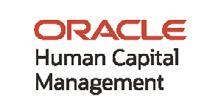 LEARN MORE
LEARN MORE
LEARN MORE
LEARN MORE
LEARN MORE
LEARN MORE
LEARN MORE
LEARN MORE
LEARN MORE
LEARN MORE
A DVERTISE WITH U S
13 targeted Publications to reach Your audience
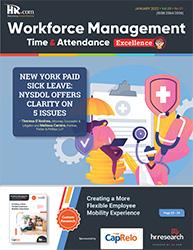
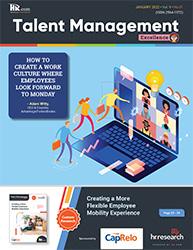
Informing, Educating, Enlightening and Assisting HR professionals in their personal and professional development, the Excellence series offers high-quality content through the publications!

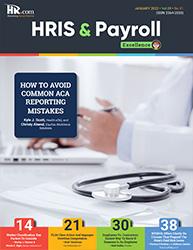



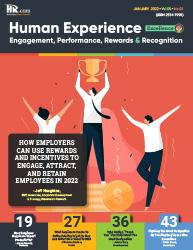





Like to submit an article? Use our online submission form or for more information go to www.hr.com/ExcellencePublications Publications
